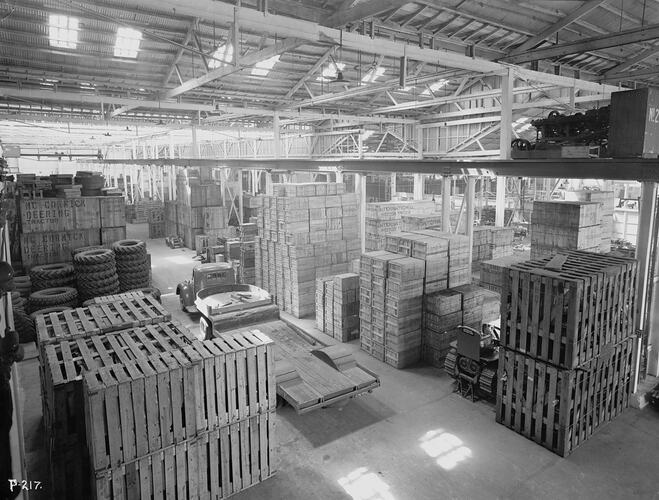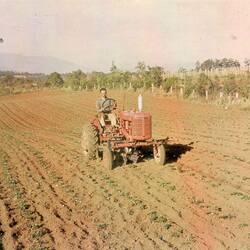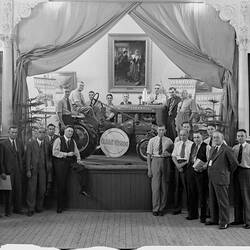Summary
Part of a large collection of glass plate and film negatives, transparencies, photo albums, product catalogues, videos, motion picture films, company journals, advertisements and newspaper cuttings relating to the operations of the International Harvester Company and its subsidiaries in Australia.
The International Harvester Company of America was formed in 1902 by the merger of five leading American agricultural machinery manufacturers. An Australian subsidiary was established in 1904 to manage Australian distribution and sales and over subsequent decades International Harvester became a major competitor to local manufacturers like H.V. McKay's Sunshine Harvester Works.
Later International Harvester established its own Australian manufacturing works, producing agricultural equipment (and later tractors) at Geelong from 1939, motor trucks at Dandenong from 1952 and earthmoving and construction equipment at Port Melbourne from 1958.
Description of Content
Interior of the International Harvester Co machinery storage warehouse in South Melbourne, showing rows wooden crates of various sizes in stacks. Painted on crates at the rear left are the words "MC CORMICK DEERING TRACTOR" "RADIATOR DO NO USE NAILS", in front of which are stack of rubber tractor tyres. In the isle in the centre is parked a semi-tractor consisting of an International Harvester prime mover with a goose-neck low floor trailer with rounded frontend. This appears to be the same truck as the one that appears in images MM115010, MM115017 & mm115018 carrying Farmall tractors on a promotional tour. At front right are two large open-slatted crates that appear to contain crawler tractors, and immediately behind them can be seen the rear-end of a TracTracTor International Harvester crawler tractor sitting on axle stands. In the isle in the background are further large crates with stencilled painted writing on them reading "INTERNATIONAL MOTOR TRUCK" "IHC MELBOURNE". Overhead travelling cranes span two bays of the warehouse and are identified with the labels "No.1" and "No.2". The roof of the warehouse is constructed of timber trusses with inverted Queen truss steel rod bracing. The roof appears to be of corrugated iron with numerous rows of skylights providing natural lighting. There is also a row of suspended electric flood lights running down the centre of each isle.
Physical Description
Black & white cellulose acetate photographic negative.
More Information
-
Collection Names
International Harvester Photographic Collection, International Harvester (IH) Collection
-
Collecting Areas
-
Acquisition Information
Donation from International Trucks Pty Ltd, by Nov 1992
-
Place & Date Depicted
Harvester House, City Road, South Melbourne, Greater Melbourne, Victoria, Australia, 07 Mar 1940
-
Creator
International Harvester Co of Australia Pty Ltd (IHC), South Melbourne, Greater Melbourne, Victoria, Australia, 07 Mar 1940
-
Format
Negative, 8" X 6", Black & White
-
Brand Names
IH (Agricultural Equipment) , IH (Motor Trucks) , International Harvester (Agricultural Equipment) , International Harvester (Motor Trucks)
-
Classification
-
Category
-
Discipline
-
Type of item
-
Image Dimensions - Negative/s
210 mm (Width), 162 mm (Height)
-
Keywords
Agricultural Equipment, Agricultural Machinery, Factory Departments, Motor Trucks, Motor Vehicles, Tractors


